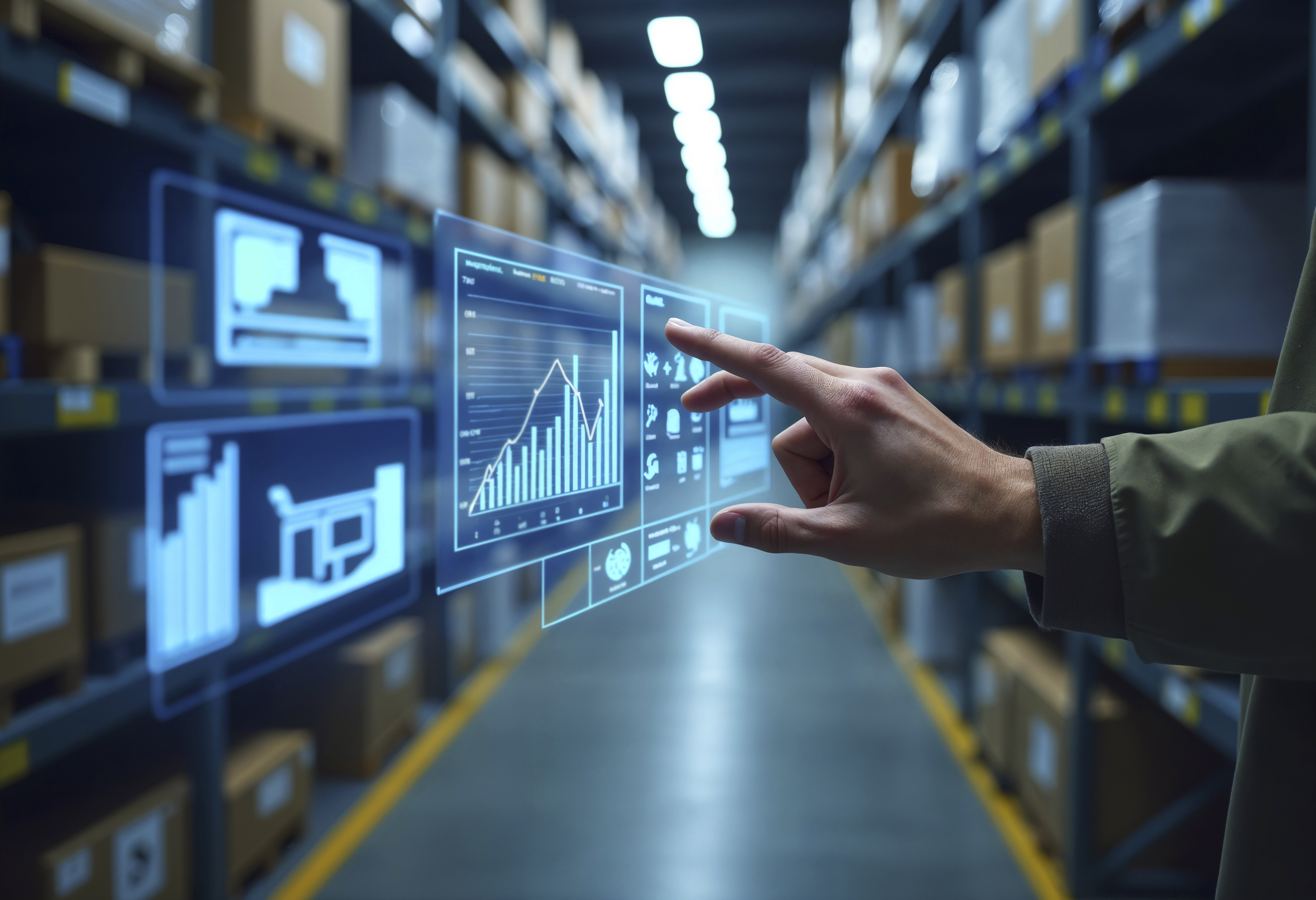AI in logistics is projected to save businesses $15.5 trillion by 2035. This staggering number isn’t just hype.
Businesses that implement AI across their supply chains gain real advantages over competitors, delight their customers, and slash operational spending. The trick is knowing exactly how to apply AI effectively in your logistics and supply chain operations. I want to break this down for you.
I’m going to walk you through what AI actually means for supply chains, why everyone’s suddenly investing, and which specific techniques are working right now for demand forecasting, inventory control, route planning, and shipment tracking. You’ll see actual cases of companies using AI to transform their logistics. And yes, we’ll tackle the hard stuff too—building proper data systems and helping your team adapt to these changes. By the time you finish reading, you’ll understand how AI tools can turn old-school supply chain operations into lean, data-powered machines.
Understanding AI in Supply Chain
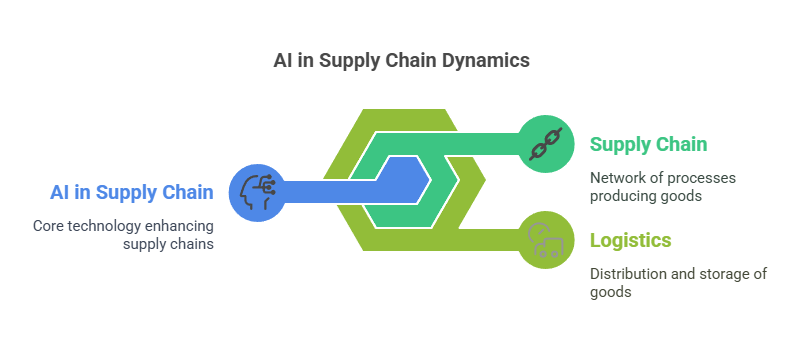
Specifically applied through machine learning algorithms, forecasting analytics, and automated systems that improve operational efficiency, supply chain AI embodies tangible business applications rather than abstract theory. These implementations cover a wide range of crucial business operations, from warehouse automation and fulfillment optimization to demand planning and forecasting.
Let’s clarify our terms: Artificial Intelligence (AI) refers to the technologies that enable computer systems to recognize significant patterns in historical data, adapt to new information, and make intelligent decisions that resemble human reasoning. This entails analyzing vast volumes of data (sales figures, seasonal trends, weather reports, shipment delays, etc.) across supply chains to extract insights that would be impossible to locate by human means.
- Supply Chain: All of the interconnected businesses, endeavors, and assets that collaborate to produce goods and distribute them to consumers. This includes the extraction of raw materials, production, transportation, inventory storage, and delivery.
- Logistics: The essentials of distributing, storing, and transporting goods along your supply chain.
The terms “logistics” and “supply chain,” though sometimes confused, are not exactly the same. Consider the supply chain as the ecosystem as a whole, whereas logistics deals with distribution and transportation in particular. That’s why AI applications span such diverse areas—from robots in warehouses to algorithms deciding the fastest delivery routes in real-time.
Why AI Now?
Although the idea of artificial intelligence is not new, recent developments in processing power, data processing, and algorithm design have made solutions more affordable and widely available. Even smaller businesses can leverage AI applications in supply chain to improve operational efficiency. Actually, the typical barrier isn’t necessarily the technology itself; rather, it’s about having clean, well-structured data. We’ll cover that challenge later.
Another factor boosting AI adoption is the shifting expectations of customers. With next-day shipping and on-demand product availability becoming the norm, companies need to predict changes in demand at nearly real-time speed. Traditional forecasting methods can’t keep up. By integrating AI-driven models, managers gain the ability to maintain just enough stock while avoiding the heavy costs of overstocking or the nasty problem of stockouts.
Key Applications of AI in Supply Chain
To keep your operations lean and responsive, consider focusing on some core areas where AI excels. These are demand forecasting, inventory optimization, route planning, and real-time tracking. Each area leverages a different facet of AI technology, but combined, they can have a truly transformative effect on day-to-day operations.
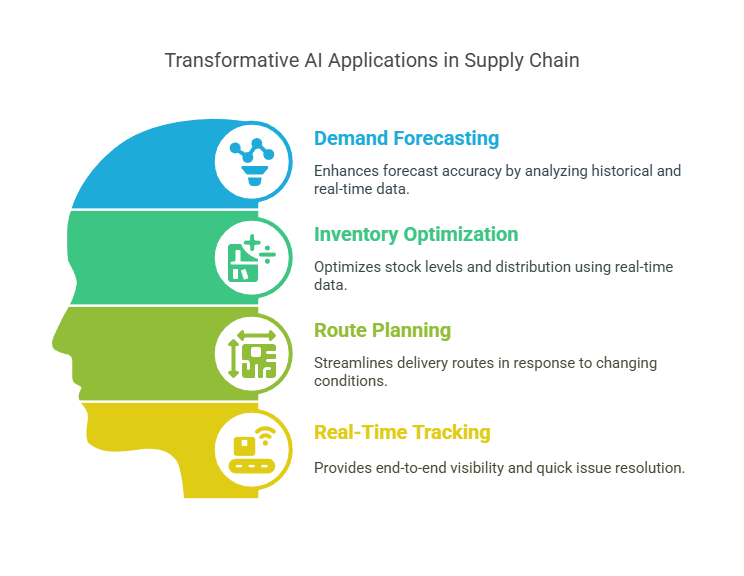
1. Demand Forecasting
In many industries, getting a handle on future product demand is half the battle. If you overestimate demand, you’re stuck with too many products in inventory. If you underestimate, well, your customers might wait endlessly for backordered items or switch to a competitor. AI in supply chain and logistics can drastically raise forecast accuracy by incorporating external variables that are often ignored in traditional forecasting.
Machine learning algorithms process large pools of historical data and cross-reference them with real-time trends (economic indicators, weather patterns, competitor pricing, social media sentiment). Then, they produce more nuanced insights about future demand. You might wonder how AI could accomplish such feats with so many different data inputs. The answer is layered neural networks (among other techniques) that uncover patterns impossible for a human to detect manually. That said, there’s a risk in believing these forecasts are infallible. The real world is messy. Good analytics teams know to keep continual oversight and refine models regularly.
Practical Example: Seasonal Retail Surges
A major apparel retailer once struggled with unpredictable seasonal trends. By deploying machine learning models, they integrated local weather forecasts to determine heavy coat demand. Sales soared, and they avoided last-year’s fiasco of bulging warehouses filled with unsold inventory. That’s AI solutions in supply chain at work: bridging the gap between known historical trends and unexpected external factors.
2. Inventory Optimization
Efficient inventory management goes beyond just forecasting demand. It’s about visualizing the pipeline, seeing where products are, and deciding how best to store or move them. AI can dynamically adjust reorder points and fine-tune safety stock based on real-time data, ensuring you always have just the right amount of product in each location.
Integration with Internet of Things (IoT) sensors in warehouses or trucks can feed real-time inventory levels directly into an AI platform. The system then signals distribution centers and procurement teams to reorder or reallocate stock before a shortage hits. Better yet, it can spot slow-moving items and recommend price modifications or promotions to increase turnover. This is a smarter approach than simply setting static reorder levels based on guesswork or outdated trends.
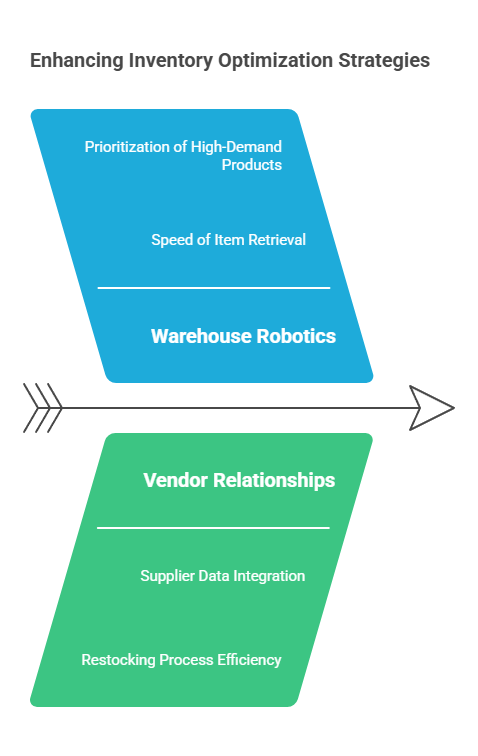
- Warehouse Robotics: Some warehouses use AI-driven robots that pick items faster than humans could. At times, these robots communicate with a centralized AI system to ensure they’re picking the highest-demand products first.
- Vendor Relationships: By integrating supplier data, the AI alerts vendors when stock is low, expediting restocking processes and further smoothing the supply chain.
3. Route Planning
Route planning is one of the more visible impacts of AI in logistics and supply chain. We’ve all used GPS apps to navigate traffic, but businesses require a far more sophisticated technique to manage multiple shipments, routes, and constraints (driver hours, vehicle capacity, customer deadlines). Advanced AI algorithms can do real-time route optimization, taking into account sudden changes, from road closures to weather disruptions.
Traditional route planning might take months to perfect before rollout, only to become outdated when unexpected factors strike. AI solutions in supply chain can pivot almost immediately, redistributing loads and updating drivers in near real-time. This dynamic approach cuts fuel consumption, shortens delivery times, and helps meet those ever-important customer expectations.
Example: Major Logistics Provider
One international logistics provider used an AI-based route planning engine that integrated all sorts of data: traffic patterns, historical weather, road incidents, and truck idle times. The result? They reduced total route distance by 10 percent, saving millions of dollars on fuel and maintenance. The improvement in on-time deliveries also boosted customer satisfaction, a bonus that can be just as significant as cost savings.
4. Real-Time Tracking
Gone are the days of customer service reps repeatedly saying, “We’re not sure where your package is right now.” With AI-assisted real-time tracking, companies get an end-to-end view of shipments, down to each container’s exact location. The system can also analyze shipping patterns and detect anomalies (like suspicious delays or diversions).
Real-time tracking can incorporate data from GPS, IoT sensors, and third-party logistics providers. When integrated into a dashboard, managers have line-of-sight visibility to promptly handle any hiccups. Something that used to take hours to resolve (a missing pallet in the warehouse, for instance) can now be spotted and addressed in minutes.
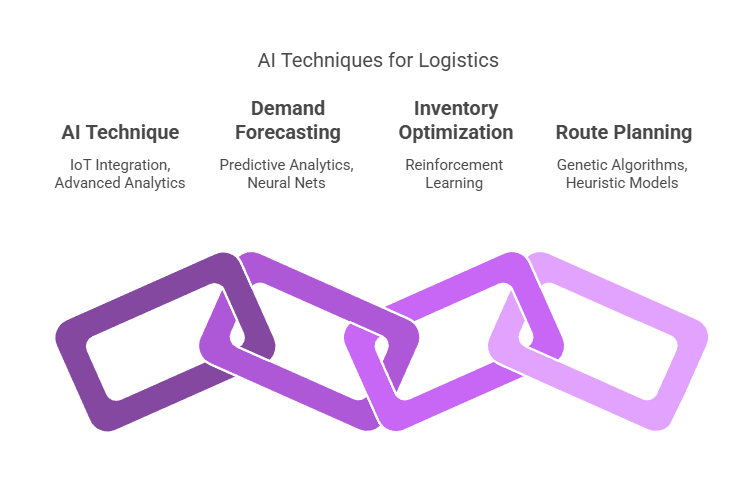
| Use Case | AI Technique |
|---|---|
| Demand Forecasting | Predictive Analytics, Neural Nets |
| Inventory Optimization | Reinforcement Learning |
| Route Planning | Genetic Algorithms, Heuristic Models |
| Real-Time Tracking | IoT Integration, Advanced Analytics |
Real-World Case Studies
It helps to see tangible stories of AI in supply chain and logistics. While many large enterprises have led the way, smaller companies are also gradually experimenting with AI applications in supply chain. Let’s briefly highlight three:
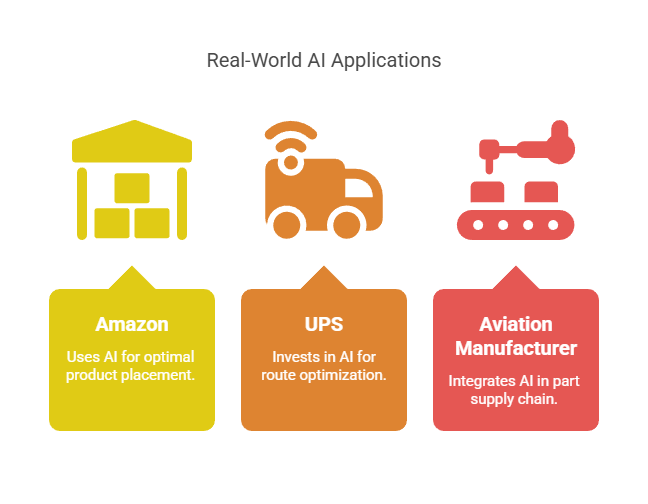
- Amazon: Known for its mammoth supply chain, Amazon uses AI to determine optimal product placement in warehouses, forecast demand for new listings, and automate picking with robots. Their recommendation engine, often mentioned for e-commerce personalization, also feeds valuable insights into supply chain decisions. If a product is trending in a particular region, Amazon locates it closer to that region, reducing shipping times.
- UPS: UPS invests heavily in route optimization through an AI-powered system called ORION. This system learns from endless streams of route data to plot the most efficient paths for each driver. By some estimates, optimizing a single mile per driver per day can translate to hundreds of millions of dollars in savings annually.
- Aviation Manufacturer: A well-known aircraft manufacturer integrated AI into its part supply chain, which is notoriously complex given safety requirements and multi-tier supplier networks. The AI model predicted part failures before they occurred, drastically reducing maintenance downtime and ensuring a continuous production line flow.
Overcoming Implementation Challenges
Deploying AI in supply chain and logistics might look simple on a glossy PowerPoint slide, but everyday reality can be more complicated. One big hurdle is data quality.Without timely and reliable information, AI simply cannot perform well. Before an AI solution can extract valuable insights from your company’s data, it must be unified and cleaned if it is dispersed among several antiquated systems (or even spreadsheets).
Another challenge: workforce adaptation. Workers are uneasy with new digital workflows or fear robots may replace them in their professions. In reality, AI replaces time-consuming and repetitive jobs, allowing staff members to concentrate on strategic planning and innovative problem-solving. However, in order for the workforce to feel educated and empowered, leadership must devote time to change management.A lack of buy-in can stifle progress early on.
We should also note that ROI from AI in supply chain might not be immediate. Sometimes it takes months or even a year to see the real impact, whether it’s reduced lead times or lowered inventory overhead. That can be frustrating for executives who expect near-instant returns. It’s helpful to define clear performance metrics from the outset (such as fill rate or on-time delivery ratio) and track them meticulously.
Additional Considerations
Data Security and Ethics
Another interesting angle is the ethical dimension of AI in supply chain. With massive data sets flowing through networks, companies must ensure they’re handling sensitive information responsibly. Even “basic” shipping data can disclose a lot about purchasing patterns, and that data might be at risk if cybersecurity measures aren’t robust. Ensuring compliance with data protection regulations (like GDPR in Europe) should be on every manager’s radar.
Besides security, there’s the matter of algorithmic bias. AI models learn from historical data. If that data contains skewed patterns (say, favoring certain distribution routes for non-objective reasons), the AI might reinforce those biases. Companies need to be aware of potential blind spots. In a sense, it’s no longer just about cost efficiency; it’s also about fairness, sustainability, and global responsibility.
Bringing It All Together
We’ve covered plenty of ground, from demand forecasting intricacies to real-time shipment tracking. Actually, let’s refine one earlier statement about the complexities: not all data is created equal. Businesses may rely on multiple external data sources — for instance, weather data from public APIs or consumer sentiment analysis from social media feeds. As you might guess, the quality and consistency of these inputs can vary, leading to occasional anomalies in AI predictions.
A Checklist for Rolling Out AI in Supply Chains
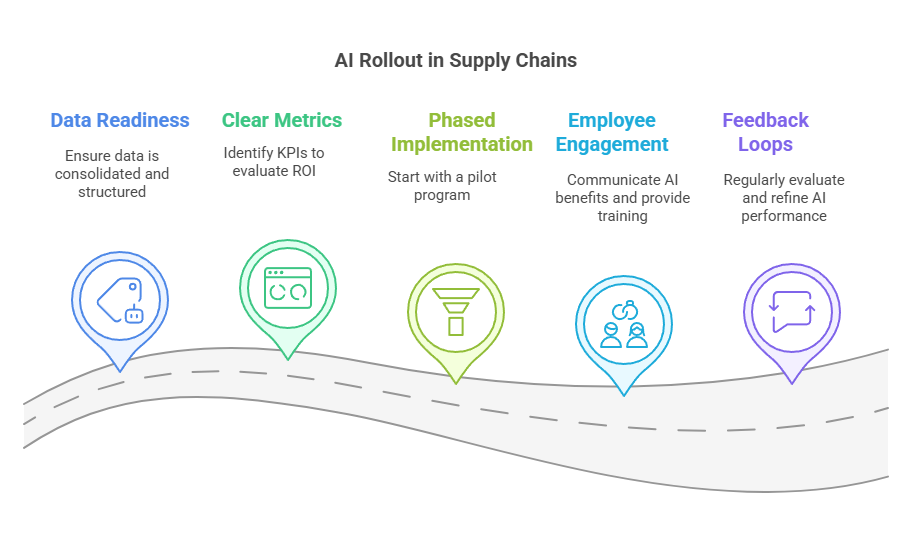
- Data Readiness: Ensure your data is consolidated, cleaned, and structured.
- Clear Metrics: Identify critical KPIs like lead time, order accuracy, or cost per shipment to evaluate ROI.
- Phased Implementation: Begin with a concentrated pilot program.
- Employee Engagement: Communicate often about the benefits of AI and provide training sessions.
- Feedback Loops: Evaluate AI performance on a regular basis and refine the algorithms.
One misconception that sometimes pops up is that AI is somehow a magic wand. A company invests in a fancy system, flicks a switch, and everything transforms. It’s never quite that effortless. AI needs careful oversight, iterative improvements, and consistent stakeholder involvement. Yet, the payoff — improved efficiency, more accurate planning, and better customer experience — can be enormous.
Word of Caution and a Thoughtful Aside
There is one less obvious consideration that many overlook: scaling your AI systems in tandem with your business growth. If your AI application runs well for your current shipment volume, congratulations. But as you expand internationally, your data volume might double or triple. Without robust planning for scaling your computing resources, you can quickly outgrow your initial AI solutions in supply chain.
But there’s a bright side, too. Cloud providers and specialized AI platforms now offer flexible environments that automatically scale based on usage. That means advanced demand forecasting can ramp up to handle bigger data sets without giving your IT team a meltdown. This is especially handy if your business experiences strong seasonal peaks or sudden order spikes.
We should note that while large corporations often have the budget and staff to tackle these challenges head-on, smaller businesses might face more difficulties in establishing data pipelines or hiring experts to run them. Still, smaller firms also stand to gain a lot from adopting targeted AI solutions in supply chain, as even a small efficiency gain is noticeable on tight margins.
Building on Earlier Points: Is AI Worth the Investment?
Earlier, we highlighted how AI is particularly effective for forecasting and inventory. Let’s add another dimension here: building resilience in a constantly shifting market. The pandemic taught everyone a hard lesson about supply chain fragility, with factories shutting down overseas and shipping routes gridlocked. AI solutions that simulate various what-if scenarios help companies pivot quickly, whether it’s rerouting shipments or sourcing from local suppliers. So beyond cost savings and better planning, AI stands as a bulwark against unexpected disruptions.
Conclusion
AI in supply chain is no passing trend. The evidence is mounting that AI solutions in supply chain environments improve everything from accuracy in forecasting to the speed of deliveries. The technology can boost efficiency, drive new business strategies, and reshape how managers, employees, and partners collaborate.
Yet the journey isn’t always smooth — data must be refined, teams need upskilling, and models must be tested and validated. Some organizations still trip up over suspicions about AI “replacing jobs,” when in reality, it frequently frees employees to address higher-level tasks. Also watch out for security concerns and the ethical dimension, ensuring AI doesn’t reinforce negative biases or put sensitive data at risk.
In the modern business world, leveraging AI effectively can mean the difference between scraping by and delivering top-tier service. Adapting it to logistics and supply chain operations brings immediate benefits like shorter lead times, better route planning, and more precise inventory control. Those benefits often lead to improved financial outcomes and happier end customers. Indeed, it’s a fascinating time to be exploring AI applications in supply chain.
And as you consider the path forward, keep an experimental mindset. Implement in manageable phases, gather consistent feedback, and let data drive your decisions. With the right approach, companies both large and small can harness the power of AI in logistics to streamline operations, enhance resilience, and propel their brand into a tech-enabled future.

